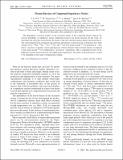| dc.contributor.author | Sheikh, J. A. | |
| dc.contributor.author | Nazarewicz, W. | |
| dc.contributor.author | Kerman, Arthur Kent | |
| dc.contributor.author | Pei, J. C. | |
| dc.date.accessioned | 2010-02-05T16:37:00Z | |
| dc.date.available | 2010-02-05T16:37:00Z | |
| dc.date.issued | 2009-05 | |
| dc.date.submitted | 2008-12 | |
| dc.identifier.issn | 0031-9007 | |
| dc.identifier.uri | http://hdl.handle.net/1721.1/51380 | |
| dc.description.abstract | The dependence of fission barriers on the excitation energy of the compound nucleus impacts the survival probability of superheavy nuclei synthesized in heavy-ion fusion reactions. In this work, we investigate the isentropic fission barriers by means of the self-consistent nuclear density functional theory. The relationship between isothermal and isentropic descriptions is demonstrated. Calculations have been carried out for [superscript 264]Fm, [superscript 272]Ds, [superscript 278]112, [superscript 292]114, and [superscript 312]124. For nuclei around 278112 produced in “cold-fusion” reactions, we predict a more rapid decrease of fission barriers with excitation energy as compared to the nuclei around [superscript 292]114 synthesized in “hot-fusion” experiments. This is explained in terms of the difference between the ground-state and saddle-point temperatures. The effect of the particle gas is found to be negligible in the range of temperatures studied. | en |
| dc.description.sponsorship | National Nuclear Security Administration under the Stewardship Science Academic Alliances program | en |
| dc.description.sponsorship | Department of Energy | en |
| dc.language.iso | en_US | |
| dc.publisher | American Physical Society | en |
| dc.relation.isversionof | http://dx.doi.org/10.1103/PhysRevLett.102.192501 | en |
| dc.rights | Article is made available in accordance with the publisher's policy and may be subject to US copyright law. Please refer to the publisher's site for terms of use. | en |
| dc.source | APS | en |
| dc.title | Fission Barriers of Compound Superheavy Nuclei | en |
| dc.type | Article | en |
| dc.identifier.citation | Pei, J. C. et al. “Fission Barriers of Compound Superheavy Nuclei.” Physical Review Letters 102.19 (2009): 192501. (C) 2010 The American Physical Society. | en |
| dc.contributor.department | Massachusetts Institute of Technology. Center for Theoretical Physics | en_US |
| dc.contributor.department | Massachusetts Institute of Technology. Department of Physics | en_US |
| dc.contributor.approver | Kerman, Arthur Kent | |
| dc.contributor.mitauthor | Kerman, Arthur Kent | |
| dc.relation.journal | Physical Review Letters | en |
| dc.eprint.version | Final published version | en |
| dc.type.uri | http://purl.org/eprint/type/JournalArticle | en |
| eprint.status | http://purl.org/eprint/status/PeerReviewed | en |
| eprint.grantNumber | DE-FG02-96ER40963 | en |
| eprint.grantNumber | DE-FC02-07ER41457 | en |
| eprint.grantNumber | DE-AC05-00OR22725 | en |
| eprint.grantNumber | DE-FG03-03NA00083 | en |
| dspace.orderedauthors | Pei, J.; Nazarewicz, W.; Sheikh, J.; Kerman, A. | en |
| mit.license | PUBLISHER_POLICY | en |
| mit.metadata.status | Complete | |
